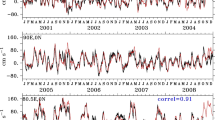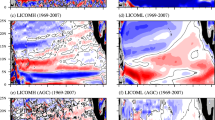Summary
The goal of this paper is to study the typical seasonal cycle of the North Equatorial Countercurrent (NECC) in the whole Tropical Atlantic Ocean using hydrographic and CTD data of 1911 to 1992. Profiles of density in the upper 500 m layer were calculated using monthly profiles of temperature and salinity averaged over one degree mesh and standard state equation. Then the typical seasonal cycle of density (monthly av eraged over entire period of observation) was analysed using the Fourier method. The sum of the averaged magnitude and annual/semi-annual harmonics characterizes a “pure” seasonal cycle. Monthly zonal geostrophic currents were calculated using “pure” monthly density fields in the northern Tropical Atlantic Ocean from 3° to 24° N. The level of no motion was postulated at 500 m. Zonal currents were obtained at the me ridional sections along 20δ, 23δ 30δ, and 45δ W. Then, a zonal transport was calculated in the following lay ers: 0 to 50, 0 to 100, 0 to 200 and 0 to 500 m. Besides, monthly meridional geostrophic currents were calculated along 3°, 5° and 8° N using the same algorithm. Our results confirm the existence of two NECC jets in the western and central Tropical Atlantic Ocean (from April to September and from September to De cember, respectively). At the same time, they show that there are three jets of the NECC during the first half of the year. The maximum total transport of the NECC in the central Tropical Atlantic Ocean is about 60 Sv (in November). Three branches of the NECC are also observed during the typical seasonal cycle in the vi cinity of 20° W. The multijet structure of the NECC in the whole Tropical Atlantic Ocean and the phases of the annual and semi-annual harmonics confirm that there are several sources generating the NECC. The possible generators are discussed in detail. Our results confirm that there are three main sources of the NECC, namely Ekman pumping, Rossby waves, and meridional monsoon winds in the eastern Tropical At lantic Ocean. The bottom relief and West Africain shore configuration are responsible (at least partly) for the NECC bifurcation in the eastern Tropical Atlantic.
Zusammenfassung
Das Ziel dieser Arbeit ist es, den typischen jahreszeitlichen Zyklus des Nordäquatorialen Gegenstroms (NECC) im gesamten tropischen Atlantik zu untersuchen, wobei hydrographische und CTD-Daten von 1911 bis 1992 benutzt wurden. Es wurden Dichteprofile der oberen 500 m berechnet. Hierfür dienten monatliche Profile von Temperatur und Salzgehalt, gemittelt in Eingradfeldern unter Benutzung der Standard-Zustandsgleichung. Dann wurde die typische jahreszeitliche Schwankung (monatliche Mittelwerte über den gesamten Zeitraum) mit der Fouriermethode analysiert. Die Summe aus Mittelwert und der jährlichen/halbjährlichen Harmonischen charakterisieren die “reine” jahreszeitliche Schwankung. Monatliche geostrophische Zonalstömungen wurden mit Hilfe der “reinen” Dichtefelder im nördlichen tropischen Atlantik zwischen 3° und 24° N berechnet. Das “level of no motion” wurde in 500 m Tiefe angenommen. Für Meridionalschnitte auf 20, 23, 30 und 45° W wurden zonale Strömungen bestimmt. Dann wurde ein zonaler Transport in den Schichten 0-50, 0-100, 0-200 und 0-500 m berechnet. Auf gleiche Weise wurde außerdem die monatliche geostro phische Meridionalströmung auf 3°, 5° und 8° N bestimmt. Unsere Ergebnisse bestätigen die Existenz von zwei NECC-Jets im westlichen und zentralen tropischen Atlantik (von April bis September bzw. September bis Dezember).Gleichzeitig zeigen die Ergebnisse, daß in der ersten Jahreshälfte drei NECC-Jets existieren. Das Maximum des totalen Transports des NECC im zentralen tropischen Atlantik liegt bei 60 Sv (im Novem ber). Drei Zweige des NECC werden außerdem im typischen jahreszeitlichen Zyklus in der Umgebung von 20°W beobachtet. Die Multijet-Struktur des NECC im ganzen tropischen Atlantik und die Phasen der jährli chen und halbjährlichen Harmonischen bestätigen, daß der NECC von mehreren Quellen angeregt wird. Die möglichen Generatoren werden im Detail diskutiert. Unsere Ergebnisse zeigen drei Hauptquellen des NECC: die Eman-Pumpe, Rossby-Wellen und die meridionalen Monsunwinde im östlichen tropischen Atlantik. Das Bodenrelief und die westafrikanische Küstenformation sind - zumindest teilweise - für die Gabelung des NECC im östlichen tropischen Atlantik verantwortlich.
Similar content being viewed by others
References
Arnault, S., 1987: Tropical Atlantic Geostrophic Currents and Ship Drifts.J. Geoph. Res.,C92, 5076–5088.
Artamonov, Yu. V., N. P. Bulgakov, andA. B. Polonsky, 1993: Large-scale structure and variability of the oceanographie fields in the North Tropical Atlantic. In: Hydrophysics of the Tropical Atlantic (edited byV. Eremeev). Kiev: Science press, 7-34 (in Russian).
Artamonov,Yu. V., A. B. andPolonsky, 1989: The sea sonal variability of hydrophysical characteristics of the Tropical Atlantic (parts 1, 2). In: Collected papers “Re search of Tropical Atlantic” MGI AN Uk.SSR, Sevasto pol, 7-60, (in Russian).
Artamonov, Yu. A., S. A. Baev, andA. B. Polonsky, 1996: On a seasonal variability of the North Equatorial Countercurrent in the Tropical Atlantic. Proceedings of St. Petersburg Hydrometeorological Institute (submit ted).
Baev, S. A., andA. B. Polonsky, 1991: The seasonal vari ability of the North Equatorial Countercurrent in the cen tral part of the Tropical Atlantic.Oceanology, 31, 217–222, (in Russian).
Bubnov, V. A., andV. D. Egorihin, 1977. Study of the large-scale structure of the currents in the Tropical At lantic Ocean along 23.5 W.Oceanology,6, 954–961 (in Russian).
Bubnov, V. A., andS. E. Navrotskja, 1986: The variabil ity of dynamic topography and surface geostrophic cur rents in the Central Tropical Atlantic.Oceanology,25, 395–402, (in Russian).
Didden, N., andF. Schott, 1992: Seasonal Variations in the Western Tropical Atlantic. Surface Circulation from Geast Altimetry and WOCE Model Results.J. Geoph. Res.,97, 3529–3541.
Dzhiganshin, G. F., andA. B. Polonsky, 1996a: Kinemat ic structure and transports of the currents in the North-West Tropical Atlantic.Marine Hydrophys. J.,2, 27–42 (in Russian).
Dzhiganshin, G. F., andA. B. Polonsky, 1996b: Seasonal variability of kinematic structure and transports of the currents in the North-West Tropical Atlantic.Marine Hy drophys. J.,6, 39–55 (in Russian).
Garzoli, S. L, andE. J. Katz, 1983: The Forced Annual Reversal of the Atlantic North Equatorial Countercur rent.J. Phys. Oceanogr.,13, 2082–2090.
Katz, E. J., 1981: Dynamic topography of the sea surface in the Equatorial Atlantic.J. Marine Res.,39, 53–63.
Katz, E. J., 1993: An interannual study of the Atlantic North Equatorial Countercurrent.J. Phys. Oceanogr.,23, 116–123.
Korotaev, G. K., andG. A. Chepurin, 1989: The mechanism of the seasonal reorganization of large-scale fields of currents in the northern part of the Tropical Atlantic. In: Collected papers “Research of the Tropical Atlantic” Sevastopol, 148-165, (in Russian).
Khanaichenko, N. K., 1974: System of the Equatorial Countercurrents in the World Ocean. Leningrad, Hydrometeoizdat, 176p., (in Russian).
Merle, J., 1983: Seasonal variability of subsurface thermal structure in the Tropical Atlantic Ocean. Hydrodynamics of the Equatorial Ocean.Elsevier Oceanogr. Series.,36, 31–49.
Merle, J., andArnault, S., 1985: Seasonal variability of the surface dynamic topography in the Tropical Atlantic Ocean.J. Marine Res.,43, 267–288.
Mittelstaedt, E., 1983: The upwelling area off N-W Africa — A description of phenomena related to coastal upwelling. Prog.Oceanogr.,12, 307–331.
Philander, S. G. H., 1976: Instability of zonal equatorial currents.J. Geophys. Res.,81, 3725–3735.
Polonsky, A. B., E. G. Nlkolaenko, Secou Konate, andToumany Camara, 1993: A study of the Equatorial Atlantic Currents using historical moored data.Dt. Hydrogr.Z.,45, 219–254.
Reverdin, G., P. Delecluse, C. Levy, P. Andrich, A. Moliere, andJ. M. Verstraete, 1991: The near surface Tropical Atlantic in 1982–1984: Results from a numerical simulation and a data analysis,Prog. Oceanog.,27, 273–340.
Richardson, P. L., andT. K. Mckee, 1984: Average Seasonal variation of the Atlantic. Equatorial Currents from Historical Ship Drifts.J. Phys. Ocean.,14, 1226–1238.
Richardson, P. L., G. E. Hufford, andR. Limeburner, 1994: North Brazil current retroflection eddies.J. Geophys. Res.,99, N C3, 5081–5093.
Author information
Authors and Affiliations
Rights and permissions
About this article
Cite this article
Polonsky, A.B., Artamonov, Y.V. North equatorial countercurrent in the tropical Atlantic: Multi- jet structure and seasonal variability. Deutsche Hydrographische Zeitschrift 49, 477–495 (1997). https://doi.org/10.1007/BF02764342
Received:
Accepted:
Published:
Issue Date:
DOI: https://doi.org/10.1007/BF02764342




